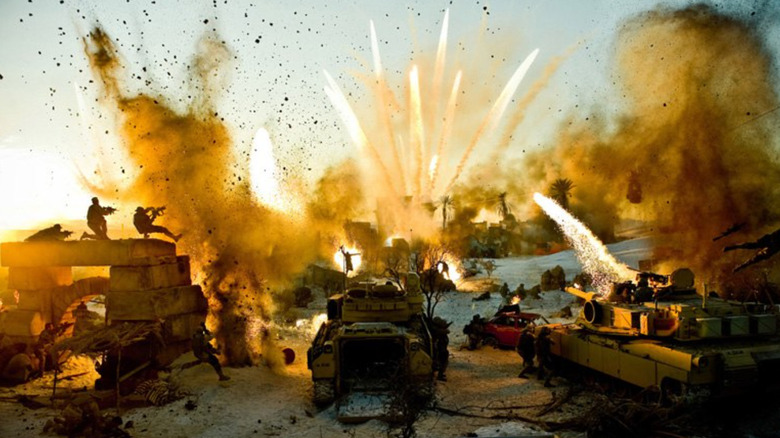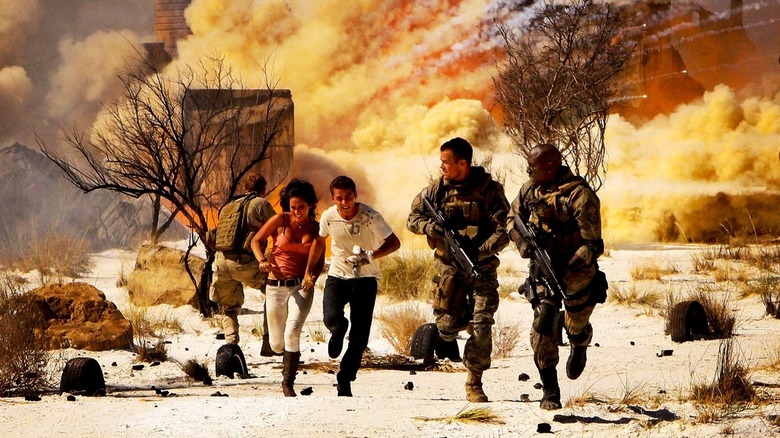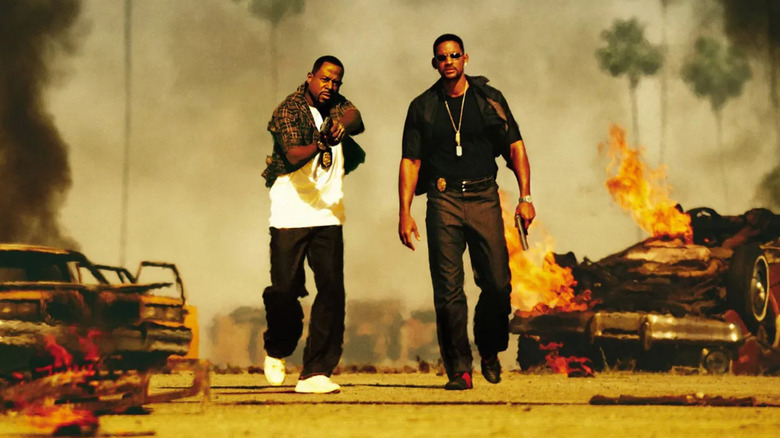This Is What Sparked Michael Bay's Obsession With Explosions
Director Michael Bay's love for pyrotechnics and movie explosions is a meme at this point. His films aren't just action films, they're pure "Bayhem." Everyone knows that if you're seeing one of his movies, be it a period piece romance like "Pearl Harbor" or sentient robots fighting in "Transformers," at the very least, the explosions are going to look good. "Robot Chicken" even had a bit where Michael Bay just puts out a film with no plot, just fireworks and big booms. Honestly, that might be kind of cathartic at this point, like ASMR relaxation videos for people who like to smash things to get their anxiety out.
While it can seem to be a bit much at times, Bay's predication to pack as many action effects as possible on a screen seemingly comes from a truly organic love of the art of pyrotechnics. His film "Transformers: Revenge of the Fallen" even made it into the Guinness Book of World Records in 2009 "for the biggest explosion on film with actors present." But where did his fascination come from?
A Lifelong Fascination
Like many filmmakers, Michael Bay got his start by making home movies. As a kid, he was apparently already a bit of a fire bug, loving to film little junior-sized explosions for his films. One stunt included setting firecrackers off on a toy train. He expounded on that experience with USA Today, speaking from the set of "Transformers: Revenge of the Fallen."
"I actually set my bedroom on fire once," Bay admitted. "The fire department came. It was a little Super 8 movie where the aliens invaded. I got grounded. Two weeks."
That obviously didn't discourage him — it just grew his desire to create bigger effects. The Pentagon and U.S. military were even roped into several of his projects, granting Bay and his crew access to helicopters and stealth fighters. You don't get much more true-to-life than filming so many scenes with live ammo that "buckets and buckets" of shells have to be picked up between takes.
The realism is the point. Bay sees more than just a cool effect in the explosions he's so known for. Bay seems to be of the opinion that CGI shortcuts take something away from the audience experience, hence his preference for practical effects where possible. In another interview with Whalebone, he waxed poetic about the soul of a film, and how audiences find it through lighting, something hard to get right with computers:
"I think it takes a lot of the soul out of it, that's what it is. It takes the soul out of it. It kind of becomes a little bit too computerized. Everyone understands light because they see light all the time but they may not understand it. But they understand when it looks screwed up. They can't articulate it but they know, oh that looks fake. It looks fake because you know what everything looks like when you're walking around and you see how light hits things and sets kind of just make it, it becomes more plastic and just doesn't have that soul to it."
That's a genuinely thoughtful comment about something many people wouldn't put too much thought into. Bay seems to be referring to something akin to the uncanny valley, wherein people see humanlike robots or CGI characters that are almost lifelike, but something unnatural makes them uncomfortable with the sight. With something like an explosion, or fire, it might not generate the sort of disgust many feel when seeing a creepy CGI human, but it can take away from a film's experience. Some visuals are too clean, too precise to be believed.
CGI versus Practical Effects
The state of CGI versus practical effects is an ongoing balance for respecting both a budget and a vision. It's also made more complicated when the desire for realism comes at the risk to human lives, like on the set of the film "Rust," in which cinematographer Halyna Hutchins was fatally shot by actor Alec Baldwin, or when other crew members and performers from many other projects lost their lives and limbs for the sake of a shot.
The trick seems to be finding balance. Even Bay can't rely solely on practical effects. When looking at a list of the most influential visual effects in movies, you'll find films with exceptional post-production CGI, but most are also testaments to on-set practical effects. Movie magic requires both. Good practical effects and CGI deliver strong verisimilitude, which connects an audience to the story.
As for Bay, the director has come a long way from blowing up toys to blowing up bigger toys. He's been able to live the dream of every kid who has made their own practical effects for home movies, hoping to repeat things in their own backyard that they've seen in theaters. Consider this a PSA: you have to be careful when playing Film Director as a child. If you're not careful, that little joyous obsession with figuring out how to make fake blood for costumes, or cool lighting effects with mirrors and flashlights, can turn into joining the A/V club in high school or going to film school. There's the slim chance that you turn into the mightily successful Michael Bay. Just try to not set your house on fire.


